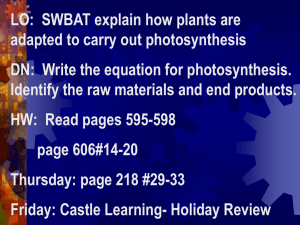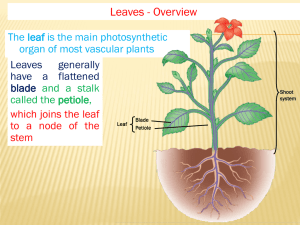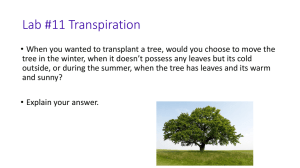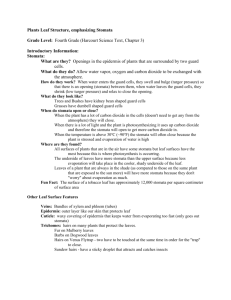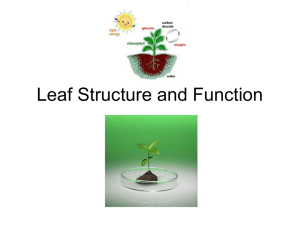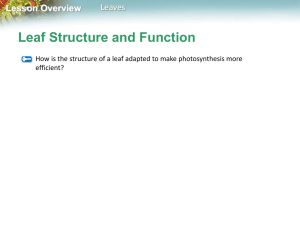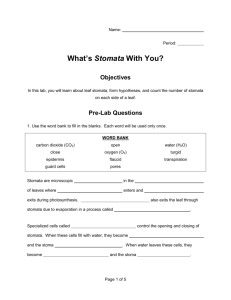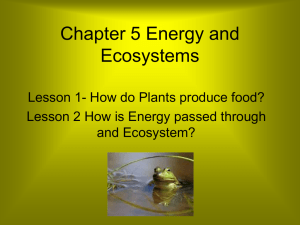Bitki Biyolojisi Ders 4 Leaf
advertisement
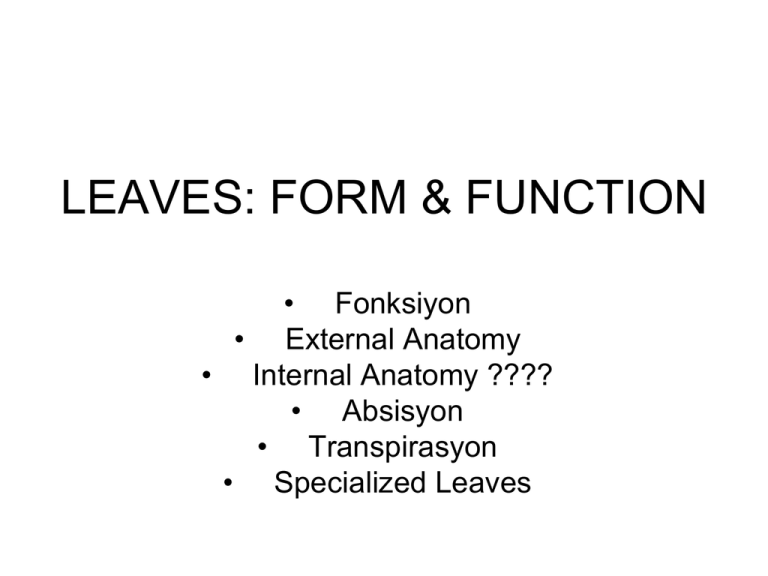
LEAVES: FORM & FUNCTION • Fonksiyon • External Anatomy • Internal Anatomy ???? • Absisyon • Transpirasyon • Specialized Leaves The Plant Body: Leaves • Fonksiyon – Güneş enerjisi ve CO2 toplayıcısı – Bazı bitkilerde belirli fonk. İçin özelleşmiş (modifiye) – Transpirasyon Dış Anatomi • • • • • blade veya lamina marjin Vein (vascular bundles) petiole stipule EXTERNAL ANATOMY Filotaksi – gövdede yaprak dizilimi Yaprak çeşitleri: Simple, compound, peltate ve perfoliate • Simple leaf = bölünmemiş lamina, petiol tabanında tek axillary bud • Compound leaf = leaflet (yaprakçık) halinde, leafletlarda axillary bud yok sadece compund yaprak tabanında bulunur – pinnat-compound leaves: yaprakçıklar çiftli ve merkezi rachis üzerinde (gül) – palmat-compound leaves: yaprakçıklar petiolün sonunda aynı noktadan çıkar (at kestanesi) • Peltate leaves = petiol blade ortasından bağlanır • Perfoliate leaves = sessile leave (yapışık yaprak) stemi çevreler Leaf types – Pinnately & Palmately Compound Leaves Peltate & Perfoliate Leaves Mayapple Yellow Wort Venation (Damarlanma) = yaprakta venlerin dağılımı • Netted-venation = bir veya birkaç dominant midvein vardır aralarda daha ince ağsı damarlar bulunur (dicotlar) – Pinnately-veined leaves = midrib denen ana damar, burdan orjinlenen secondary veinler – Palmately-veined leaves = veinler blade tabanından ayrılır (maple). • Paralel venation = monocots (grasses, cereal grains); venler birbirine paralel • Dikotomus venation = midrib veya büyük venler yok; benzer ebatta cok sayıda ven çatal oluşturarak tabandan iki farklı yöne gider, fan şekilli yaprak Venation Types Netted or Reticulate Venation Absisyon Abscission Auxin (Oksin, IAA) Etilen (C2H4) absisyona etkisi?? IAA C 2H 4 • Etilenin etkileri - yaşlanma - yapraktaki oksin miltarı azalma - cellulase gibi duvarı inhibe eden enzimlerde artış - Hücrelerde şişme ve parçalanma Abscission program 1. Mobilizasyon 2. Cork oluşumu 3. Detachment (Ayrılma) 1. Mobilization Önemli materyalleri ana gövdeye transport eder – – – – Proteins Chlorophyll Starch DNA Proteins, DNA, starch, etc aa signal + + enzymes aa, glucose 2. Cork formation – Absisyon zonu altında: • Absisyon zonunun altındaki parenkimatik hücreler cell wall’da suberin ve lignin miktarını artırır (protective cork) 3. Detachment – abscission zone: • Parenkima hücreleri bazi cell wall enzimleri salgılar (glucanases and pectinases); self digest • Hücler su alır şişer TRANSPIRATION • Plants must supply water to all their tissues. It moves from the roots up the stem to the leaves by capillary action. • The evaporation of water vapor from plant surfaces is called transpiration. • Stoma neden var • Stomanın açılıp kapanması transpirasyonu düzenler • Az Su, düşük sıcaklık, ışık ; kapalı • gündüz açık gece kapalı • guard cells Stomatal control GUARD CELLS AND PLANT HOMEOSTASIS • kidney-shaped with thick inner walls and thin outer walls. • When they become full of water (turgid) the unevenness of the walls causes them to bow outward and the stomate opens. • When they lose water they become less turgid and the stomate closes. • Guard cells gain and lose water by osmosis. Stomatal guard cells • Environmental factors are sensed by guard cells – Light intensity, temperature, relative humidity, intercellular CO2 concentration • Integrated into well defined responses – Ion uptake in guard cell – Biosynthesis of organic molecules in guard cells • This alters the water potential in the guard cells • Water enders them • Swell up 40-100% Plants and water • Bitkiler dehidrasyondan uzak durmak ister • water conservation X CO2 assimilation – Bazı yapılar su dengesinde önemli – 1: iyi gelişmiş root– to get water from soil – 2: suya direnç götermeyen taşıma– xylem – 3: leaf cuticle – reduces evaporation – 4: stomata – controls water loss and CO2 uptake – 5: guard cells – control stomata. Habitatlara göre bitkiler Mesophytes: plants adapted to a habitat with adequate Xerophytes: plants adapted to a dry habitat Halophytes: plants adapted to a salty habitat water Hydrophytes: plants adapted to a freshwater habitat Hydrophyte: Nemli ortam Xerophytes • Sunken stoma • Hair, air current • Waxy cuticle waterproof • Rolled leaf • Daha az stoma • Küçük yaprak • İyi kök sistemi Adaptation How it works Example thick cuticle stops uncontrolled evaporation through leaf cells small leaf surface area less surface area for evaporation low stomata density smaller surface area for diffusion sunken stomata maintains humid air around stomata marram grass, cacti stomatal hairs (trichores) maintains humid air around stomata marram grass, couch grass rolled leaves maintains humid air around stomata marram grass, extensive roots maximise water uptake cacti conifer needles, cactus spines Left and right Epidermis of the cactus Rhipsalis dissimilis. Left: View of the epidermis surface. The crater-shaped depressions with a guard cell each at their base can be seen. Right: X-section through the epidermis & underlying tissues. The guard cells are countersunk, the cuticle is thickened. These are classic xerophyte adaptations. Transverse Section Through Leaf of Xerophytic Plant . Specialized or Modified Leaves • In pine trees, the leaves are adapted to living in a dry environment too. • Water is locked up as ice during significant portions of the year and therefore not available to the plant; pine leaves possess – sunken stomata, – thick cuticles – needle-like leaves – hypodermis, which is an extra cells just underneath the epidermis – Cotyledons or “seed leaves” Çinlenen tohumun ürettiği ilk yaprak Bol miktarda besin (endospermden gelir) Tendrils Garden Pea Tendrils – yaprağın blade kısmı indirgenmiş, sarılma özelliği Böcek kapan Figure 11.8 (1) • nitrojen • Enzim • turgor Cotyledons or “seed leaves” Leaves as Colorful Bracts
